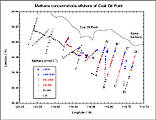Dissolved Methane
Natural marine seepage near Coal Oil Point, Santa Barbara Channel, California, injects large quantities of hydrocarbons into the coastal ocean. The dispersal and source strength of the injected methane, ethane, and propane from this seep field was determined using a variety of oceanographic and geochemical techniques. The results show that hydrocarbons seep into stratified coastal waters creating plumes that extend for at least 12 km.
The plume structure is complex because of the large geographical distribution of seep vents and because of the chaotic nature of advection and mixing near the seeps. At the time of the survey, hydrocarbons were injected onto density surfaces between sigma = 24.5 - 26.0 kg/m3.
Earlier work has shown that subsurface methane maxima in the upper waters of the southern California Bight are typically found on these density surfaces. We estimate that the total flux of methane into the water column above the Coal Oil Point seeps is 2 x 10^10 g/yr and is approximately equal to the total flux of dissolved methane to the atmosphere estimated for the entire southern California Bight.
These observations strongly support the inference of others that coastal sources, which includes some of the world's largest marine hydrocarbon seeps, maintain the methane maximum observed offshore California. Estimates of the global methane flux from coastal waters derived by extrapolating the flux from coastal California may be too large because of the anomalous amount of marine hydrocarbon seepage in these waters.

dissolved methane samples offshore of the Santa Barbara coastline

dissolved methane and propane concentrations along transects
A-A' and C-C'